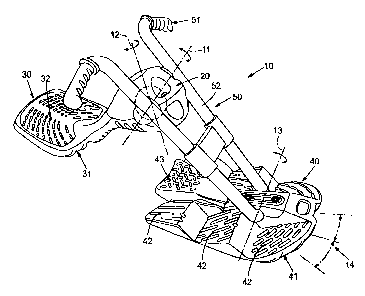Some of the information on this Web page has been provided by external sources. The Government of Canada is not responsible for the accuracy, reliability or currency of the information supplied by external sources. Users wishing to rely upon this information should consult directly with the source of the information. Content provided by external sources is not subject to official languages, privacy and accessibility requirements.
Any discrepancies in the text and image of the Claims and Abstract are due to differing posting times. Text of the Claims and Abstract are posted:
| (12) Patent Application: | (11) CA 2601404 |
|---|---|
| (54) English Title: | SNOW SLED |
| (54) French Title: | LUGE A NEIGE |
| Status: | Deemed Abandoned and Beyond the Period of Reinstatement - Pending Response to Notice of Disregarded Communication |
| (51) International Patent Classification (IPC): |
|
|---|---|
| (72) Inventors : |
|
| (73) Owners : |
|
| (71) Applicants : |
|
| (74) Agent: | SMART & BIGGAR LP |
| (74) Associate agent: | |
| (45) Issued: | |
| (86) PCT Filing Date: | 2006-03-17 |
| (87) Open to Public Inspection: | 2006-09-28 |
| Examination requested: | 2007-09-17 |
| Availability of licence: | N/A |
| Dedicated to the Public: | N/A |
| (25) Language of filing: | English |
| Patent Cooperation Treaty (PCT): | Yes |
|---|---|
| (86) PCT Filing Number: | PCT/US2006/009872 |
| (87) International Publication Number: | US2006009872 |
| (85) National Entry: | 2007-09-17 |
| (30) Application Priority Data: | ||||||
|---|---|---|---|---|---|---|
|
A snow sled for use by a seated rider is disclosed and includes a body
section, a seat section having an underside for engaging the snow and a top
side for receiving the seated rider, the seat section attached to the body
section, a foot section having an underside for engaging the snow and
positioned forward of the seat section when the snow sled is deployed in the
riding configuration and positioned adjacent the seat section when the snow
sled is retracted into the stowable configuration, and a handlebar arrangement
connecting the body section to the foot section.
La présente invention concerne une luge à neige pour utilisateur assis. Le corps de la luge comprend une structure de siège et une structure repose-pieds. Le dessus de la structure de siège accueille l'utilisateur assis, le dessous de cette structure étant au contact de la neige. Le dessous de la structure repose-pieds est au contact de la neige. Cette structure, qui vient sur l'avant du siège lorsque la luge est dépliée en configuration de glisse, se rabat contre le siège lorsque la luge est repliée en configuration de rangement. Un dispositif de guidon relie le corps au repose-pieds.
Note: Claims are shown in the official language in which they were submitted.
Note: Descriptions are shown in the official language in which they were submitted.

2024-08-01:As part of the Next Generation Patents (NGP) transition, the Canadian Patents Database (CPD) now contains a more detailed Event History, which replicates the Event Log of our new back-office solution.
Please note that "Inactive:" events refers to events no longer in use in our new back-office solution.
For a clearer understanding of the status of the application/patent presented on this page, the site Disclaimer , as well as the definitions for Patent , Event History , Maintenance Fee and Payment History should be consulted.
| Description | Date |
|---|---|
| Application Not Reinstated by Deadline | 2011-03-17 |
| Time Limit for Reversal Expired | 2011-03-17 |
| Deemed Abandoned - Failure to Respond to Maintenance Fee Notice | 2010-03-17 |
| Inactive: Abandoned - No reply to s.30(2) Rules requisition | 2010-03-01 |
| Inactive: S.30(2) Rules - Examiner requisition | 2009-09-01 |
| Amendment Received - Voluntary Amendment | 2009-06-15 |
| Letter Sent | 2008-08-18 |
| Inactive: Single transfer | 2008-05-13 |
| Inactive: Cover page published | 2007-12-07 |
| Letter Sent | 2007-12-05 |
| Inactive: Acknowledgment of national entry - RFE | 2007-12-05 |
| Inactive: First IPC assigned | 2007-10-18 |
| Application Received - PCT | 2007-10-17 |
| National Entry Requirements Determined Compliant | 2007-09-17 |
| Request for Examination Requirements Determined Compliant | 2007-09-17 |
| All Requirements for Examination Determined Compliant | 2007-09-17 |
| Application Published (Open to Public Inspection) | 2006-09-28 |
| Abandonment Date | Reason | Reinstatement Date |
|---|---|---|
| 2010-03-17 |
The last payment was received on 2009-03-04
Note : If the full payment has not been received on or before the date indicated, a further fee may be required which may be one of the following
Patent fees are adjusted on the 1st of January every year. The amounts above are the current amounts if received by December 31 of the current year.
Please refer to the CIPO
Patent Fees
web page to see all current fee amounts.
| Fee Type | Anniversary Year | Due Date | Paid Date |
|---|---|---|---|
| Request for examination - standard | 2007-09-17 | ||
| Basic national fee - standard | 2007-09-17 | ||
| MF (application, 2nd anniv.) - standard | 02 | 2008-03-17 | 2008-02-22 |
| Registration of a document | 2008-05-13 | ||
| MF (application, 3rd anniv.) - standard | 03 | 2009-03-17 | 2009-03-04 |
Note: Records showing the ownership history in alphabetical order.
| Current Owners on Record |
|---|
| WHAM-O, INC. |
| Past Owners on Record |
|---|
| DAVID J. FITZGERALD |